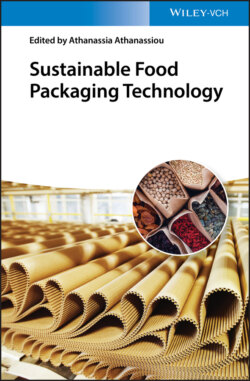Читать книгу Sustainable Food Packaging Technology - Группа авторов - Страница 25
1.3.10 Cellulose and Derivatives
ОглавлениеCellulose is the most abundant natural polymer on earth. The major source of cellulose is certainly wood, which contains 40–50 wt%, being the fundamental component of the cell walls of plants and natural fibers. Cellulose is a linear naturally occurring polymer composed of 1,4‐linked‐β‐D‐anhydroglucopyranose units that are covalently linked via acetal functions between the equatorial –OH group of C4 and the C1 carbon atom [108]. Neat cellulose is, however, unsuitable for film production because it is highly crystalline and also insoluble in water due to the strong intra‐ and intermolecular hydrogen bonding between the individual chains and its highly crystalline structure [109]. Therefore, cellulose is usually dissolved in a mixture of sodium hydroxide and carbon disulfide and recast into sulfuric acid. This chemical treatment results in the production of the so‐called cellophane film, which has good mechanical properties. However, it is often coated with nitrocellulose wax or PVDC to improve its moisture sensitiveness. Coated cellophane is then used for baked goods, fresh products, processed meat, cheese, and candy though it is not heat sealable due to its non‐thermoplastic nature [110].
Alternatively, cellulose can be chemically modified to produce water‐soluble cellulose ester or ether derivatives by either esterification or etherification, respectively, of individual hydroxyl groups on the polysaccharide backbone. Commercial derivatives of cellulose include cellulose acetate, ethyl cellulose, hydroxylethylcellulose, and hydroxyl‐propyl cellulose, among others [111]. Figure 1.7 summarizes some of the hydrophilic and hydrophobic cellulose derivatives categorized according to their pH‐responsive behavior and chemistry. Steps involved in making these thermoplastic materials include, first, making cellulose derivatives biopolymers in powder form and, thereafter, extruding them in the presence of different additives and plasticizers such as citrates. Although the gas and moisture barrier properties of cellulose acetate are not optimal for food packaging, this film is excellent for products demanding high moisture as it allows respiration and reduces fogging [110]. Mazzucchelli (Castiglione Olona, Italy) and Planet Polymer (California, USA) manufacture biodegradable plastics under the trade names of BIOCETA® and EnviroPlastic® Z, respectively, based on cellulose acetate. BIOCETA® has been applied for the manufacture of biodegradable packaging films, retractable films, and tubes [98].
